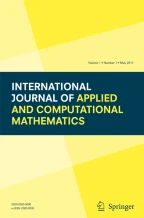Abstract
This article establishes a branch–bound technique to solve nonlinear convex–convex fractional multi-objective optimization problem in the non-convex feasible region. As far as the authors are concerned, this kind of problem is not solved by any other author in the literature. By transformation, multi-objective non-linear fractional problem is transformed into a multi-objective non-linear optimization problem. After giving preferences of weight to each objective, the original NLFMOOP is transformed into a nonlinear single-objective programming problem. Lagrange’s theorem of weak duality is used to find lower and upper bound for single objective nonlinear optimization problems in the feasible region. Some theoretical results for solving the multi-objective non-linear fractional problem have also been established. For showing the application of the proposed method, it has been applied to two numerical problems.
Similar content being viewed by others
References
Mishra, B., Nishad, A.K., Singh, S.R.: Fuzzy multi-fractional programming for land use planning in agricultural production system. Fuzzy Inf. Eng. 6, 245–262 (2014)
Leber, M., Kaderali, L., Schonhuth, A., Schrader, R.: A fractional programming approach to efficient DNA melting temperature calculation. Bioinformatics 21(10), 2375–2382 (2005)
Naeem, M., Illanko, K., Karmokar, A., Anpalagan, A., Jaseemuddin, M.: Optimal power allocation for green cognitive radio: fractional programming approach. IET Commun. 7, 1279–1286 (2013). ISSN 1751-8628
Goedhart, M.H., Spronk, J.: Financial planning with fractional goals. Eur. J. Oper. Res. 82(1), 111–124 (1995)
Fasakhodi, A.A., Nouri, S.H., Amini, M.: Water resources sustainability and optimal cropping pattern in farming systems; a multi-objective fractional goal programming approach. Water Resour. Manag. 24, 4639–4657 (2010)
Antczak, T.: A modified objective function method for solving nonlinear multiobjective fractional programming problems. J. Math. Anal. Appl. 332, 971–989 (2006)
Rodenas, R.G., Lopez, M.L., Verastegui, D.: Extension of Dinkelbach’s algorithm for solving non-linear fractional programming problems. Soc. Estad. Investig. Oper. 7(1), 33–70 (1999)
Ammar, E.E.: On the optimality of nonlinear fractional disjunctive programming problems. Comput. Math. Appl. 53, 1527–1537 (2007)
Tantawy, S.: An iterative method for solving linear fraction programming (LFP) problem with sensitivity analysis. Math. Comput. Appl. 13(3), 147–151 (2008)
Tsai, J.F.: Global optimization of nonlinear fractional programming problems in engineering design. Eng. Optim. 37(4), 399–409 (2005)
Bhurjee, A.K., Panda, G.: Nonlinear fractional programming problem with inexact parameter. J. Appl. Math. Inform. 31, 853–867 (2013)
Phong, T.Q., Hoai An, L.T., Tao, P.D.: Decomposition branch and bound method for globally solving linearly constrained indefinite quadratic minimization problems. Oper. Res. Lett. 17, 215–220 (1995)
Yamamoto, R., Konno, H.: An efficient algorithm for solving convex–convex quadratic fractional programs. J. Optim. Theory Appl. 133, 241–255 (2007)
Dai, Y., Shi, J., Wang, S.: Conical partition algorithm for maximizing the sum of dc ratios. J. Global Optim. 31, 253–270 (2005)
Benson, H.P.: Using concave envelopes to globally solve the nonlinear sum of ratios problem. J. Global Optim. 22, 343–364 (2002)
Benson, H.P.: Global optimization algorithm for the nonlinear sum of ratios problem. J. Optim. Theory Appl. 112(1), 1–29 (2002)
Freund, R.W., Jarre, F.: Solving the sum of ratios problem by an interior point method. J. Global Optim. 19, 83–102 (2001)
Ruan, N., Gao, D.Y.: Global solutions to fractional programming problem with ratio of nonconvex functions. Appl. Math. Comput. 255, 60–72 (2015)
Costa, J.P.: An interactive method for multi objective linear fractional programming problem. OR Spectrum 27, 633–652 (2005)
Costa, J.P., Alves, M.J.: A reference point technique to compute non-dominated solutions in MOLFP. J. Math. Sci. 161(6), 820–831 (2009)
Valipour, E.: An interactive approach to solve multi objective linear fractional programming problems. Appl. Math. Model. 38, 38–49 (2014)
Linderoth, J.: A simplicial branch-and-bound algorithm for solving quadratically constrained quadratic programs. Math. Program. Ser. 103, 251–282 (2005)
Sharma, V.: Multi-objective integer nonlinear fractional programming problem: a cutting plane approach. Opsearch 49(2), 133–153 (2012)
Benson, H.P.: Branch-and-bound outer approximation algorithm for sum-of-ratios fractional programs. J. Optim. Theory Appl. 146, 1–18 (2010)
Shen, P.P., Duan, Y.P., Pei, Y.G.: A simplicial branch and duality bound algorithm for the sum of convex–convex ratios problem. J. Comput. Appl. Math. 223, 145–158 (2009)
Zhou, X., Cao, B.: A simplicial branch and bound duality-bounds algorithm to linear multiplicative programming. J. Appl. Math. 2013, Article ID 984168 (2013)
Guzel, N., Sivri, M.: Taylor series solution of multi-objective linear fractional programming problem. Trakya Univ. J. Sci. 6(2), 80–87 (2005)
Guzel, N.: A proposal to the solution of multi-objective linear fractional programming problem. In: Abstract and Applied Analysis 2013, Article ID 435030. Hindawi Publishing Corporation, London (2013)
Bhati, D., Singh, P.: Branch and bound computational method for multi-objective linear fractional problem. Neural Comput. Appl. 28, 3341–3351 (2016). https://doi.org/10.1007/s00521-016-2243-6
Agarwal, D., Singh, P., Bhati, D., Kumari, S., Obaidat, M.S.: Duality-based branch-bound computational algorithm for sum-of-linear-fractional multi-objective optimization problem. Soft Comput. 23(1), 197–210 (2019)
Agarwal, D., Singh, P., Li, X., Kumari, S.: Optimality criteria for fuzzy-valued fractional multi-objective optimization problem. Soft Comput. 23(19), 9049–9067 (2019)
Horst, R., Tuy, H.: Global Optimization: Deterministic Approaches. Springer, Berlin (1996)
Author information
Authors and Affiliations
Corresponding author
Additional information
Publisher's Note
Springer Nature remains neutral with regard to jurisdictional claims in published maps and institutional affiliations.
Rights and permissions
About this article
Cite this article
Singh, P., Agarwal, D., Bhati, D. et al. A Branch–Bound Cut Technique for Non-linear Fractional Multi-objective Optimization Problems. Int. J. Appl. Comput. Math 6, 29 (2020). https://doi.org/10.1007/s40819-020-0771-3
Published:
DOI: https://doi.org/10.1007/s40819-020-0771-3
Keywords
- Fractional optimization
- Duality
- Branch–bound
- Optimal solution
- Multi-objective fractional optimization
- Nonlinear optimization
